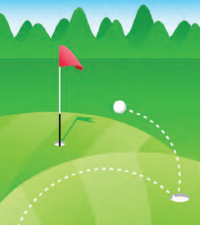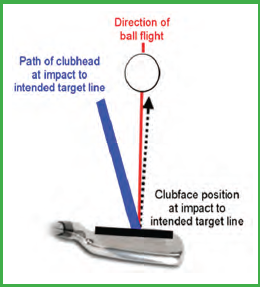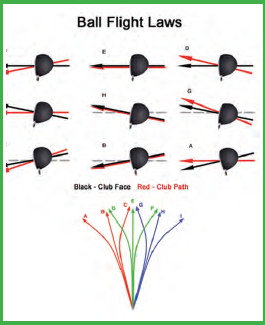Simplifying the Ball Flight Laws: Traditional vs. Modern
Ball Flight Laws are Simple Physics
 Physics involves the study of matter and its motion through space and time, along with related concepts such as energy and force. Striking a golf ball is simple physics; therefore, this action follows the laws of physics. The golf ball has no preconceived bias when it is struck. It is simply ACTION – REACTION!
Physics involves the study of matter and its motion through space and time, along with related concepts such as energy and force. Striking a golf ball is simple physics; therefore, this action follows the laws of physics. The golf ball has no preconceived bias when it is struck. It is simply ACTION – REACTION!
The physics of golf ball flight laws have not changed. The past interpretations were less than adequate because of lack of technology, and unwillingness to put science over tradition. There is nothing new, as the physics of ball flight from 200 years ago are still the same as today. In fact, many instructors and players in the past, understood the “modern ball flight” concept. It just was not pushed to the mainstream until modern technology helped further prove the science.
As someone with a science background, I questioned the traditional ball flight laws when I first was exposed to them years ago. Certainly, many others in the past questioned those concepts, as well. Several instructors in the past even published opinions contradicting traditional ball flight laws decades ago. There is evidence that Ben Hogan’s concept of ball flight laws was right on target with what modern high-speed technology proves.
To facilitate this discussion, let’s establish a benchmark – the intended target line. This is the line drawn from the ball to the intended target. The intended target line is the benchmark for two major factors in ball flight laws: path of clubhead at impact and position of clubface at impact.
There are five human performance factors that affect distance and direction:
1. Path of the Clubhead at Impact to the Intended Target Line
2. Position of Clubface at Impact to the Intended Target Line
3. Angle of Approach
4. Centeredness of Contact
5. Clubhead Speed
 Obviously, other factors can influence distance and direction such as climate, weather, terrain and quipment. These are not “human performance factors.” For this discussion, these factors will be constant and non-influencing.
Obviously, other factors can influence distance and direction such as climate, weather, terrain and quipment. These are not “human performance factors.” For this discussion, these factors will be constant and non-influencing.
Traditional Ball Flight Laws of the Past
Here is a simple explanation: Ball flight laws in the past almost always followed the thinking that the golf ball will start off in the direction of the path of the clubhead at impact to the intended target line. It would then only deviate left or right in accordance to the position of the clubface at impact to the intended target line. This has been proven to be false.
The Modern Ball Flight Laws
The development of high-speed cameras and ball-tracking equipment such as TrackMan has demonstrated that the “traditional” ball flight physics were misunderstood. The true reality is that the ball will primarily start off in the direction of the clubface position at impact to the intended target line.
The modern ball flight laws are based on the fact that the ball’s flight pattern is primarily dependent on the clubface orientation at impact. Eighty-five percent of the ball’s initial flight direction is determined by the clubface position at impact to the intended target line. Only 15 percent of the initial flight direction is dependent on the path of the clubhead at impact.
If the ball has any curvature in the air, it is caused by the differential between the clubface and the path of clubhead at impact. Therefore, the greater the difference between the clubface position at impact in relationship to the path of the club at impact, the greater amount of curvature on the golf ball as it travels. In simple terms, the more the clubface is open to the swingpath line, the more the ball will have “slice” spin. The more the clubface is closed to the swingpath, the more the ball will have “hook” spin.
 On a center-struck shot, the ball will never cross the path of the clubhead unless it is moved by an outside force such as the wind. Remember that clubface position at impact dictates around 85 percent of the initial flight of the golf ball. It is also important to remember that there is no such thing as pure sidespin on a golf ball. The golf ball rotates around one single spin axis. The degree of tilt on the spin access dictates the flight of the golf ball. We will go more into depth on spin axis in future articles.
On a center-struck shot, the ball will never cross the path of the clubhead unless it is moved by an outside force such as the wind. Remember that clubface position at impact dictates around 85 percent of the initial flight of the golf ball. It is also important to remember that there is no such thing as pure sidespin on a golf ball. The golf ball rotates around one single spin axis. The degree of tilt on the spin access dictates the flight of the golf ball. We will go more into depth on spin axis in future articles.
Summary
To be brief, the traditional ball flight laws put emphasis on the path of the clubhead at impact as the dictator of the initial ball flight. The modern ball flights laws clearly show that the position of the clubface at impact makes up nearly 85 percent of the initial ball flight.
Remember, the clubface sends it, the differential bends it!
Upcoming issues: Spin Axis, The D-Plane Concept & The Five Human Performance Factors, and How Ball Flight Laws Can Aid Your Teaching




